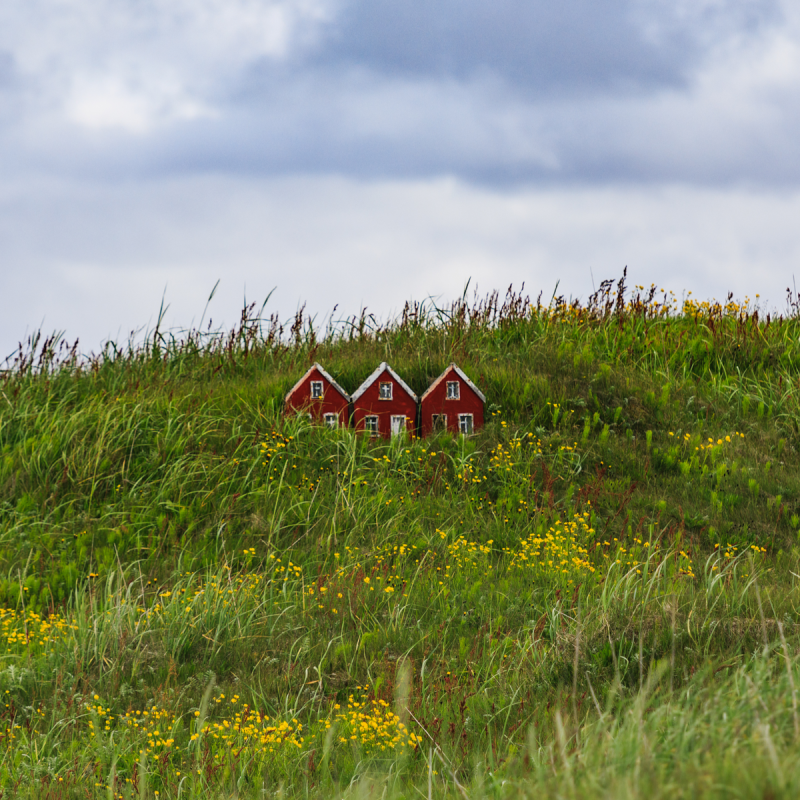
(Photo Credit: Michael Zech Fotografie / Shutterstock.com)
It was cold, my legs hurt after climbing up a glacier using an ice pick and crampons, and I was exhausted. The landscape was magical, as only the Icelandic landscape can be — somewhere between rugged and bleakly black and shimmering and stunning. Below me was a bright turquoise entrance into the glacier’s ice cave, next to me Kristjan, my guide across this slippery part of the world, about three times my height and width.
Videos by TravelAwaits
No one would doubt his Viking heritage looking at Kristjan, tall with long, red hair, bushy beard, and striking blue eyes. Imagine him with a hammer, and you’d have Thor, God of Norse mythology. But just minutes before, Kristjan had told me that he believed in fairies.
And, strangely enough, he is not alone. In fact, more than 50 percent of Icelanders either believe that elves or fairies — which most cultures believe to be the same creatures but with different names, and which in Iceland are referred to as Huldufólk, or “hidden people” — exist. Or at least they don’t believe that they don’t. So, what are these elves, fairies, or hidden people? And will you see some when you visit Iceland?
Origins Of The Folklore
Blame it on the long, dark nights in winter or the otherworldly setting of Iceland, but the hidden people make up only one part of a population of strange, mystical beings in this northern country.
There are also trolls, whose likeness makes for some of the most charming souvenirs from Iceland, with their big eyes and scraggly hair — and they seem quite common. There is Ykur, a mythical gray horse; Lagarfljótsormur, a worm-like creature not unlike the Loch Ness monster; and a few ghosts. But the Huldufólk are firmly fixed in Iceland’s culture, and there was even a protest in the early 2010s against a road being built when some protestors proclaimed it would destroy the habitat of the hidden people.
Iceland is a country where, for centuries, storytelling not only preserved history, but also kept people busy during long winter nights. There are many references and tales going back to roughly A.D. 1,000 from the Viking era. Numerous poems and tales include references to “álfar” or elves and other strange creatures, be they gigantic whales and trolls or the hidden people who live side by side with humans, just in another dimension.

(Photo Credit: HALLDOR KOLBEINS/AFP via Getty Images)
The Hidden People
The Huldufólk are, in fact, very similar to human beings. They come in numerous sizes, reportedly from a tiny few inches to taller than human size. According to local lore, some 50 species — types? — of elves live mostly in the rocky lava fields in the Icelandic countryside, and they live a life similar to that of the humans, with agricultural pursuits, attending elf churches, and living in regulated communities.

(Photo Credit: Anne Richard / Shutterstock.com)
They definitely do not wear green felt outfits or pointy shoes but can be distinguished from humans by their old-fashioned way of dressing. I guess if you see a potential elf wearing jeans, it is not an elf.
There are people who can see them and know where they live, and they often get together at Elf School to talk about their encounters and to tell other interested parties visiting Iceland about them.
Other Countries’ Beliefs
With many references to elves and similar creatures in northern Europe down to Germany, the skeptic should hedge their bet. Even I, at school in Germany, had to learn the poem Der Erlkönig by Johann Wolfgang von Goethe, a somewhat dark ballade about a father riding through the night with his child only for the king of the fairies or elves to appear, trying to tempt the child to come with him into his land of the fairies, and the child to eventually die. The inspiration for this poem was said to have come from Danish folklore and shows that these creatures can have a bit of a mean streak in them.
In the northern UK, fairies are very much part of the folklore, and all the northern European countries have references to these creatures. But they do seem to prefer living in colder climates, as the references decrease the further south you go.
Good Or Bad Elves
In the case of road construction in Iceland, it is said that the Huldufólk generally move out of the way of a useful road, but if it is not a sensible undertaking, things can start to happen around the area. Cases of misfortune befall the people involved in building the road, from engines not working to things getting lost, all credited to the elves being displeased. But laugh not, because official statements have been released by the Icelandic Road Agency as to local concerns about these events and beliefs. That said, not all elves are mischievous or nasty — others are indeed helpful and friendly. Not unlike humans, really.

(Photo Credit: Rudy Balasko / Shutterstock.com)
Where To Spot The Hidden People
Some 6 miles south of Reykjavík, Hafnarfjördur is reportedly home to the largest settlement of elves and hidden people. There are also some dwarfs and other mythical creatures. So many, indeed, that you can go on a guided walk with those in the know in the hope of spotting some.
Or you could head to the horseshoe-shaped Ásbyrgi Canyon, reportedly created by elves, and you can also go and see the so-called elf stone in Kópavogur, a southern suburb of Reykjavík, where the road is built around a great big rock which the construction company tried to remove before equipment continually failed, halting the project.
Folklore imagery is all around in Iceland, be it trolls and elves in souvenir shops, or signs on some beaches warning you of dangerous sea creatures. And when you drive past those endless fields of cushion-like moss-covered rocks, it is not difficult to imagine a community of small hidden people living there.
Pro Tips: To learn more, go on a Folklore Walking Tour; and, if you can, try and be in Iceland on January 6, which is the night most connected with the Huldufólk. Just try to avoid the mountainous regions and highlands, as this is where you are most likely to come across trolls. Here is a map of where you are most likely to bump into something you might have heard of in fairy tales.
Here’s more inspiration for your Icelandic adventure:

